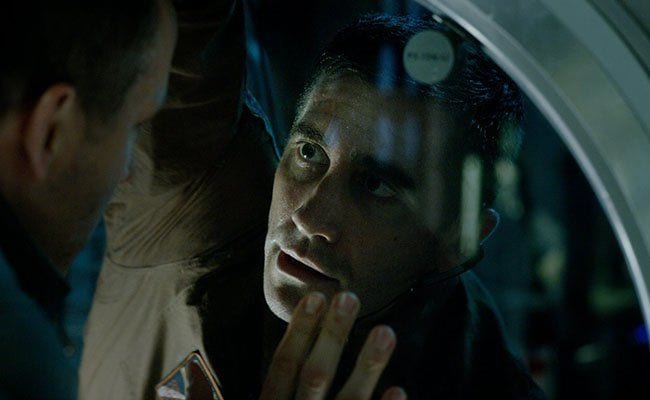
All monster horror movies are inherently goofy. As a filmmaker, you can either embrace the goofiness with over-the-top spectacle, or try to suspend audience disbelief by creating a realistic environment for your goofy monster. Life, the new space monster epic from director Daniel Espinosa, tries to play it both ways, with predictably hilarious and hackneyed results.
It’s impossible to write a review of Life without mentioning Ridley Scott’s 1979 seminal ‘haunted spaceship’ classic, Alien. Both films track frantic astronauts aboard a derelict spacecraft as they try to avoid being killed by an indestructible alien. The primary difference between the films, however, is that Life never takes the time to establish any of its characters or ground the drama in reality. Sure, there’s a feeble attempt to recreate the dining hall scene from Alien (Parker and Brett are still waiting for those full shares), but it’s mainly just an excuse to exchange witty banter. Life is paced like an action movie, forsaking the foreboding in favor of frenzy.
Director Espinosa (Child 44 (2015), Safe House (2012)) isn’t interested in building a new haunted house in space. His floating tomb is just an excuse to revisit some tired old themes. One need only consult Ian Malcolm, the sage of Jurassic Park (1993), to understand the meaning of Life. “Your scientists were so preoccupied with whether they could, they didn’t stop to think if they should,” Malcolm warns. Actually, any number of Malcolm quotes could apply to Life, most notably, “That is one big pile of shit.”
The scientist, in this case, is Hugh (Ariyon Bakare), who can’t resist poking and prodding the new single-celled Martian organism delivered to the International Space Station. Hugh floods the inert critter with enriched glucose and warm temperatures, giving no thought to the implications of successfully reviving it. The adorable little… slime… is given a name, Calvin, and within a few weeks he’s playing “pat-a-cake” with Hugh from his petri dish. Hugh marvels at how each cell can function independently, yet also operate as a cooperative unit. Then he blasts Calvin with a fancy cattle prod and all hell breaks loose.
It’s the first of many idiotic decisions made by the crew, which includes the quarantine officer, North (Rebecca Ferguson), the medical officer, Jordan (Jake Gyllenhaal), and Rory (Ryan Reynolds), a free-spirited mechanical engineer. Each character is given a single characteristic before they line up to be eaten. Jordan prefers living in space to being on Earth, North only cares about maintaining order, and Rory likes pretending that he’s Deadpool.
This shallowness and stupidity would be perfectly acceptable in an overblown schlockfest, but Espinosa and his creative team are taking things far too seriously. To their credit, the International Space Station (ISS) is breathtaking. The exhilarating opening scenes feature lots of zero gravity shenanigans, with characters buzzing around the ISS in their space jammies to enjoy the breathtaking Earth vistas looming in the background. As a technical achievement in visual effects, Life is truly impressive.
The creature design of Calvin, too, is about as dynamic and original as one could ask from a computer generated baddie. Espinosa’s team is more concerned with authenticity than terror, as Calvin is a streamlined killing machine. Gone are the questions you had in Alien, like, “How does that huge monster eat enough to survive?” or “What’s with all the drool?” That’s not to say that the ‘jelly squid’ from Life competes with Giger’s iconic monster for space supremacy, but Calvin actually looks like something you might encounter on a primordial alien world.
Despite the technical expertise and realism, however, Calvin is not scary. In fact, nothing in Life is scary. There are some minor thrills when Calvin finally breaks containment, and the ending throws us a few curveballs, but the plot follows an otherwise tired slasher film formula. The characters are too one-dimensional to warrant our concern, and there’s no attempt to establish an ominous tone of dread.
The audacity of Espinosa’s nihilistic ending, though, raises many questions about the film he intended to make. There’s a nasty streak beneath the polished veneer. In fact, stylistically, Life owes more of its inspiration to David Cronenberg than Ridley Scott. Calvin dispatches enemies with organismic efficiency from the inside out. Blood droplets dance in zero gravity as victims belch out their liquefied innards. This classic ‘body horror’ hints at something much darker than what we see in the antiseptic, brightly-lit corridors of the ISS.
This mix of realism and stylized gore is jarring, as Life can’t decide if it’s mainstream action fare or a ridiculous monster movie. The simplistic script doesn’t do this quality cast any favors, either. When Gyllenhaal gravely intones that, “It’s hard to watch people die,” you can’t help laughing.
This simplicity also undermines the thematic heft that Espinosa intended. There’s no discussion or thought given to the appropriate course of action concerning Calvin’s analysis. When Hugh observes that Calvin’s “curiosity outweighs its fear”, the delicious subtext that Humans can’t resist meddling where they don’t belong is completely wasted on these stupid characters.
There are certainly things to admire about Life, and you’ll have more than a few unintentional laughs at its expense, but it lacks a cohesive identity. Horror fans won’t be scared and sci-fi fans will find it insultingly simplistic. It’s an acceptable level of entertainment if you aren’t choosy, but anyone looking for something more gratifying will feel lost in space.


![Call for Papers: All Things Reconsidered [MUSIC] May-August 2024](https://www.popmatters.com/wp-content/uploads/2024/04/all-things-reconsidered-call-music-may-2024-720x380.jpg)



